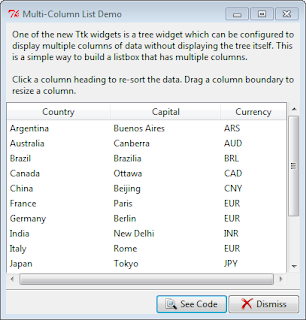Tkinter assigns the same identifier to the values in each column of the same row. For example, Argentina, Buenos Ares and ARS all have I001 as their identifier while the United States, Washington, DC and USD all have the identifier I00F. When sorting a column, you only need to move the selected column values, tkinter handles moving related items in the same row.
# File: mclist.py
# References:
# http://www.tcl.tk/man/tcl8.5/TkCmd/ttk_treeview.htm
# http://svn.python.org/projects/python/branches/pep-0384/Demo/tkinter/ttk/treeview_multicolumn.py
# http://hg.python.org/cpython/file/4e32c450f438/Lib/tkinter/font.py
from tkinter import *
from tkinter import ttk
from tkinter.font import Font
from demopanels import MsgPanel, SeeDismissPanel
class MCListDemo(ttk.Frame):
# class variable to track direction of column
# header sort
SortDir = True # descending
def __init__(self, isapp=True, name='mclistdemo'):
ttk.Frame.__init__(self, name=name)
self.pack(expand=Y, fill=BOTH)
self.master.title('Multi-Column List Demo')
self.isapp = isapp
self._create_widgets()
def _create_widgets(self):
if self.isapp:
MsgPanel(self,
[ "One of the new Ttk widgets is a tree widget ",
"which can be configured to display multiple columns of data without ",
"displaying the tree itself. This is a simple way to build a listbox that has multiple ",
"columns.\n\n",
"Click a column heading to re-sort the data. ",
"Drag a column boundary to resize a column."])
SeeDismissPanel(self)
self._create_demo_panel()
def _create_demo_panel(self):
demoPanel = Frame(self)
demoPanel.pack(side=TOP, fill=BOTH, expand=Y)
self._create_treeview(demoPanel)
self._load_data()
def _create_treeview(self, parent):
f = ttk.Frame(parent)
f.pack(side=TOP, fill=BOTH, expand=Y)
# create the tree and scrollbars
self.dataCols = ('country', 'capital', 'currency')
self.tree = ttk.Treeview(columns=self.dataCols,
show = 'headings')
ysb = ttk.Scrollbar(orient=VERTICAL, command= self.tree.yview)
xsb = ttk.Scrollbar(orient=HORIZONTAL, command= self.tree.xview)
self.tree['yscroll'] = ysb.set
self.tree['xscroll'] = xsb.set
# add tree and scrollbars to frame
self.tree.grid(in_=f, row=0, column=0, sticky=NSEW)
ysb.grid(in_=f, row=0, column=1, sticky=NS)
xsb.grid(in_=f, row=1, column=0, sticky=EW)
# set frame resize priorities
f.rowconfigure(0, weight=1)
f.columnconfigure(0, weight=1)
def _load_data(self):
self.data = [
("Argentina", "Buenos Aires", "ARS"),
("Australia", "Canberra", "AUD"),
("Brazil", "Brazilia", "BRL"),
("Canada", "Ottawa", "CAD"),
("China", "Beijing", "CNY"),
("France", "Paris", "EUR"),
("Germany", "Berlin", "EUR"),
("India", "New Delhi", "INR"),
("Italy", "Rome", "EUR"),
("Japan", "Tokyo", "JPY"),
("Mexico", "Mexico City", "MXN"),
("Russia", "Moscow", "RUB"),
("South Africa", "Pretoria", "ZAR"),
("United Kingdom", "London", "GBP"),
("United States", "Washington, D.C.", "USD") ]
# configure column headings
for c in self.dataCols:
self.tree.heading(c, text=c.title(),
command=lambda c=c: self._column_sort(c, MCListDemo.SortDir))
self.tree.column(c, width=Font().measure(c.title()))
# add data to the tree
for item in self.data:
self.tree.insert('', 'end', values=item)
# and adjust column widths if necessary
for idx, val in enumerate(item):
iwidth = Font().measure(val)
if self.tree.column(self.dataCols[idx], 'width') < iwidth:
self.tree.column(self.dataCols[idx], width = iwidth)
def _column_sort(self, col, descending=False):
# grab values to sort as a list of tuples (column value, column id)
# e.g. [('Argentina', 'I001'), ('Australia', 'I002'), ('Brazil', 'I003')]
data = [(self.tree.set(child, col), child) for child in self.tree.get_children('')]
# reorder data
# tkinter looks after moving other items in
# the same row
data.sort(reverse=descending)
for indx, item in enumerate(data):
self.tree.move(item[1], '', indx) # item[1] = item Identifier
# reverse sort direction for next sort operation
MCListDemo.SortDir = not descending
if __name__ == '__main__':
MCListDemo().mainloop()

